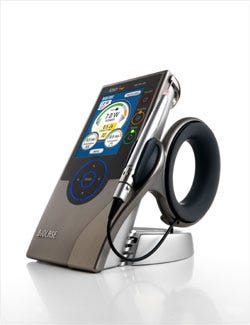Could Liquidmetal Be the Newest 'Miracle' Material for Medical?
Harder than titanium and lighter than steel, Liquidmetal has already been used in at least two medical devices that have made it to market.
May 29, 2012

Following reports that its metal alloy might be used in an upcoming iteration of the iPhone, Liquidmetal Technologies Inc. (Rancho Santa Margarita, CA) was inundated with inquiries from potential customers. Marketing manager Dennis Ogawa fielded so many calls he lost his voice.
|
Liquidmetal has a number of properties, including hardness and corrosion-resistance, that might make it a good material for use in medical devices. |
“It’s been overwhelming,” he says.
Some of the interest came from companies in the medical device space, which the company hopes will grow as a share of its business in the coming years.
Liquidmetal is the commercial name for a number of amorphous liquid metal alloys developed in the 1990s by researchers at the California Institute of Technology. Liquidmetal Technologies licensed the original alloy and has since been awarded or licensed more than 50 patents relating to the technology.
The material has characteristics that might make it a good fit for use in medical devices. Liquidmetal is harder than titanium and 20% lighter than stainless steel. It’s also biocompatible and wear-, water-, and corrosion-resistant, according to the company. Similar to plastics, the alloys can be injection molded.
“We can make [a part] in two to three minutes instead of two to three hours or two to three days,” says president Tom Steipp.
Tests by customers have shown that the material is nonmagnetic—making it potentially suitable for use in MRI—though the company has not verified those tests. Its hardness, strength, and durability also make Liquidmetal a good material for use in a variety of medical devices, including scalpels and implants, according to the company.
At least two medical device products featuring Liquidmetal have come to market. The ezlase Diode Dental Laser System, from Biolase Technology (Irvine, CA), uses the material for most of its housing, according to Biolase’s entry for the 2007 Medical Design Excellence Awards, put on by MD+DI. The material helped make the portable device durable and allowed it to achieve good heat dissipation, protection from impact and radiation, a compact size, and an ergonomic shape. Tooling costs were in line with those for similar plastic injection molding, according to the submission. The company produced five housing components in production quantities for under $50.
|
The ezlase Diode Dental Laser System, from Biolase Technology, uses Liquidmetal in its housing. |
Biolase also used Liquidmetal for the housing of the iLase, a handheld pen laser for dental procedures, says Matt Duncan, president and industrial designer at Morphix Design (San Clemente, CA), which provided contract design assistance on the iLase and ezlase. He says Biolase was drawn to the material for its strength, ability to be molded to a thin wall thickeness, and ornamental finish.
Biolase used Liquidmetal mainly for aesthetics, and Duncan says he would want to conduct more testing before using it for a mechanical purpose. “That would be the case for any material,” he says.
Liquidmetal’s limitations include poor performance in temperatures sustained above 500°F, though Ogawa says that’s not typically a concern in medical devices. Its high-cycle fatigue rate—an important factor for ultrasonic applications—is undetermined.
An 18-month study to determine the biocompatibility of the material was conducted at Louisiana State University, and the company provided MD+DI with a summary matrix of the results for two of its alloys. An expert who reviewed the document for MD+DI noted apparent typos, missing information regarding test dates, and unclear or inconclusive results.
“If a toxicologist were to look at this, they would have a problem using this to really feel comfortable signing off on it to say, ‘OK, it’s safe for use,’” says Len Czuba, an MD+DI editoral advisory board member and principal at product design and development firm Czuba Enterprises (Lombard, IL).
Ogawa responded that the summary matrix was a confidential general summary for internal company communications and for nonmedical audiences. “The animal study results are not intended to convey that the material is exhaustively studied for full toxicology or readiness for application as human implants,” he says. “The company offers to share the results of the 18-month study from Louisiana State University (conducted October 15, 2002—December 1, 2003) upon execution of a mutual NDA.”
None of the current Liquidmetal alloy families contain lead or heavy metals, but Ogawa couldn't rule out the presence of tin.
"The potential presence of tin or other materials may occur as standard components, as trace elements, or natural impurities," he told MD+DI in an e-mail.
DePuy Orthopaedics researched the material for use in knee implants in 2002. Bernice Aboud, manager for metallurgy research with Depuy, said although Liquidmetal showed “promising properties,” the company chose not to bring any products using the material to market. “...[I]t didn’t meet our needs,” spokeswoman Jessica Masuga, said in a statement. “We haven’t pursued further use of this technology.”
Duncan says medical device makers might be wary of using Liquidmetal for a couple of reasons. They might be afraid to be tied to a material with a single source or simply afraid to use something that’s fairly new and not yet widely used.
“If Apple starts using it, look out,” Duncan says. “I think that will probably legitimize it as a go-to material, at least for a while.”
—Jamie Hartford is the associate editor of MD+DI. Follow her on Twitter @readMED.
About the Author(s)
You May Also Like



.png?width=300&auto=webp&quality=80&disable=upscale)
